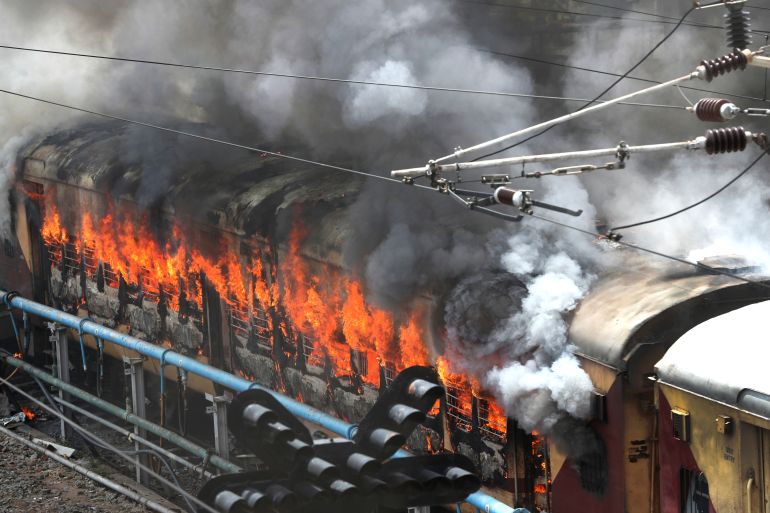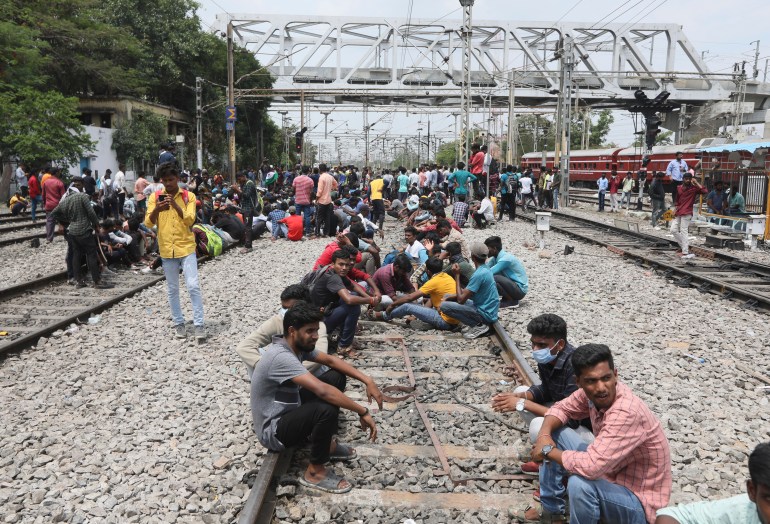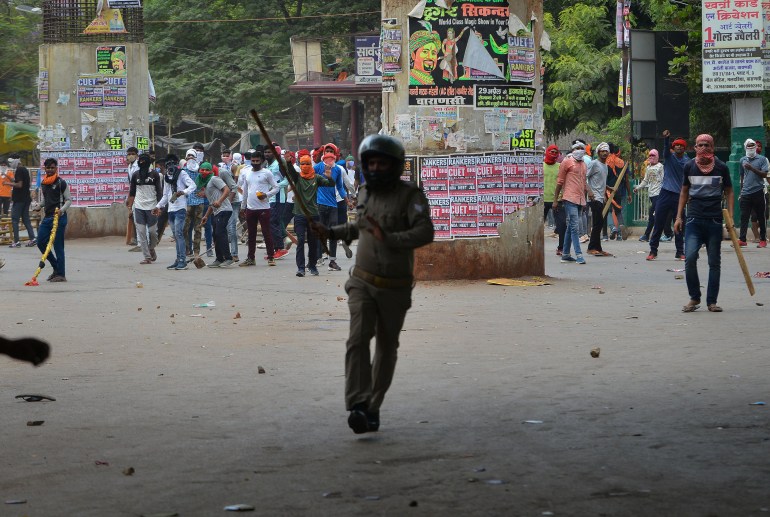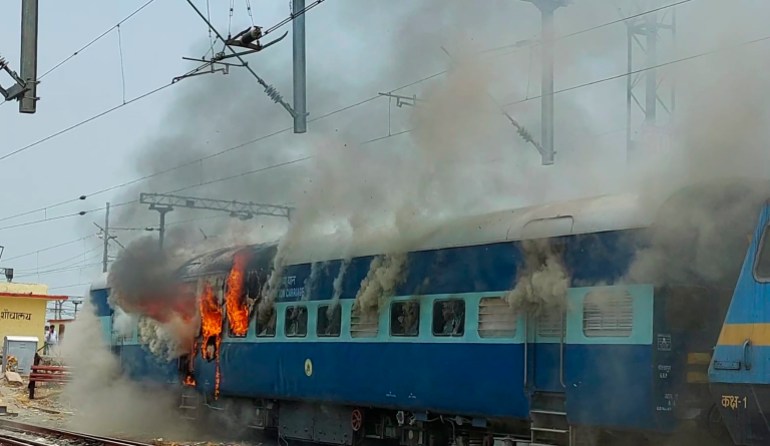One dead as India protests against new short-term army jobs widen
Man dies in Telangana state as protesters throw stones at police and set fire to train coaches in demonstrations against a new military recruitment policy.

At least one person has died and more than a dozen injured as protests against a new short-term government recruitment policy for the military enter a third day in India.
The death was reported on Friday from the southern Telangana state – a sign the protests were spreading – where police opened fire as a crowd gathered at Secunderabad railway station and torched train coaches. It was not clear if the man died in the police firing.
Keep reading
list of 4 items‘Agnipath’: What is India’s new military recruitment system?
Kashmiris working in Indian army, police continue to face attacks
Project Force: Is India a military superpower or a Paper Tiger?
Prime Minister Narendra Modi’s government announced this week an overhaul of the recruitment process for the 1.38 million-strong armed forces, aiming to bring in more people on short, four-year contracts to lower the average age of personnel.
But many potential recruits object, saying they should be allowed to serve longer than four years. Opposition parties and some members of Modi’s ruling Bharatiya Janata Party (BJP) say the system will lead to more unemployment in a country grappling with joblessness.
Police said they used batons and tear gas to disperse protesters in several states, including Bihar, Uttar Pradesh, Madhya Pradesh, Haryana and Rajasthan after crowds took to the streets, blocked railway tracks and roads, and damaged vehicles and government buildings.
Railway authorities said movement of nearly 200 trains were affected as they cancelled dozens of passenger train services and deployed additional police to railway stations to prevent further destruction, media reports said.

In Gurugram, a satellite city of India’s capital that is home to offices of several multinational firms, authorities banned gatherings of more than four people at one place in an effort to forestall demonstrations.
“This order shall come into force with immediate effect,” Gurugram’s administration said in a notice, a copy of which was posted on social media by the district’s information department.
While there have been no reports of protests in Gurugram, some demonstrators were out in the neighbouring district of Palwal on Thursday.
Some of the world’s major companies have offices in Gurugram, including Microsoft, Meta and Google. It is also home to manufacturing facilities of major Indian companies such as Maruti Suzuki.
In the northern state of Uttar Pradesh, protests erupted in 14 districts, and police fired into the air to push back stone-throwing crowds, senior police official Prashant Kumar said.

In neighbouring Bihar, the worst-hit state, protesters torched train coaches in at least two stations and disrupted rail services, police said. Nearly 25,000 police were deployed and more than 100 people arrested in the eastern state, officials said.
Bihar has some of India’s highest unemployment and poverty rates, and has earned a reputation as a state left behind by the country’s runaway economic growth of the past few decades.
In January, crowds of angry job applicants in Bihar set fire to train carriages, blocked railway tracks and burned effigies of Modi following allegations that entrance exams for the government-run railway sector were being conducted unfairly.
Reporting from New Delhi, Al Jazeera’s Pavni Mittal said there is “immense anger” among people and the “situation is out of control”.
“Violent protests are going across the country. Trains are being torched, stations are being vandalised, roads are being blocked,” she said.

‘Path of fire’
Mittal said the demand of the protesters is “simple: they want the government to roll back the new policy for army recruitment”, called “Agnipath” or path of fire in Hindi.
The policy will bring in men and women between the ages of 17 and a half and 21 for a four-year tenure at non-officer ranks, with only a quarter retained for longer periods. Seventy-five percent of them will be compulsorily retired after four years with no pension benefits.
Soldiers have previously been recruited by the army, navy and air force separately, and typically serve for up to 17 years, for the lowest ranks.
The government on Friday also announced a one-time extension for the maximum entry age into the scheme to 23 since recruitment had been frozen for the past two years, mainly because of the COVID-19 pandemic.
“The government has decided that a one-time waiver shall be granted for the proposed recruitment cycle for 2022,” the defence ministry said in a statement.
The armed forces aim to recruit about 46,000 people under the new system this year, defence minister Rajnath Singh announced earlier this week.
Singh defended the programme, saying its aim is “to strengthen the security of the country”. With nearly 1.4 million active personnel, India’s military is the world’s second largest after China, and the third-largest spender.
Modi, who is facing national elections in 2024, is under pressure to provide jobs as India’s economy recovers from the pandemic slump. One idea behind the short-term military recruitment is that those trained by the armed forces can later seek jobs with police or the private sector.
The government faced criticism from some retired soldiers, opposition leaders and security analysts.
In an analysis for Al Jazeera on Thursday, security expert Sushant Singh said the new army recruitment plan was announced without any discussion in parliament and could have “devastating consequences”.
“More than half of the Indian government’s defence expenditure of $70.6bn goes towards pensions and salaries for Indian military personnel. It was shooting upwards by the year and Modi’s government was unable to initiate a substantive reform within the existing structure,” Singh wrote. “So the Indian government on Tuesday decided to demolish the structure itself.”
According to Singh, the proposal will also have a direct bearing on the Indian society, which has seen a spike in hate speech and attacks on Muslims and other minorities by India’s right-wing Hindu groups since Modi came to power in 2014.
“Research shows that the most violent ethnic cleansing occurred when members of the majority community gained combat experience as soldiers while the minority community was unorganised,” wrote Singh.
Rahul Gandhi, a key opposition Congress party leader, urged the government to “listen to the voice of the unemployed youth of the country”.
Unemployment has long been a millstone around the Indian economy’s neck, with joblessness figures at their worst since the 1970s even before the COVID-19 pandemic wreaked havoc on the economy.
Modi’s government pitched the new military recruitment plan as a pathway to modernise the armed forces with a younger and leaner soldier corps while also creating hundreds of thousands of new jobs.
Speaking to Al Jazeera, Ghazala Wahab, executive editor of Force magazine, said the problem with the new army recruitment scheme is that it was “not thought through at all”.
“Most of the decisions this government has taken since it came to power have been executive decisions taken without any debate,” she said.